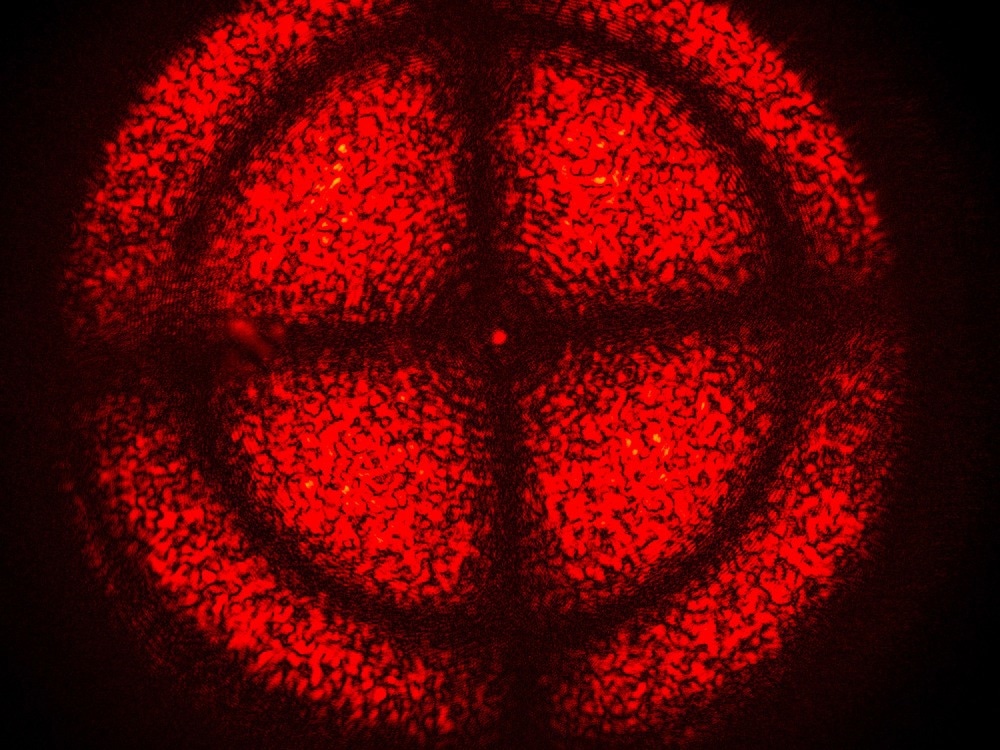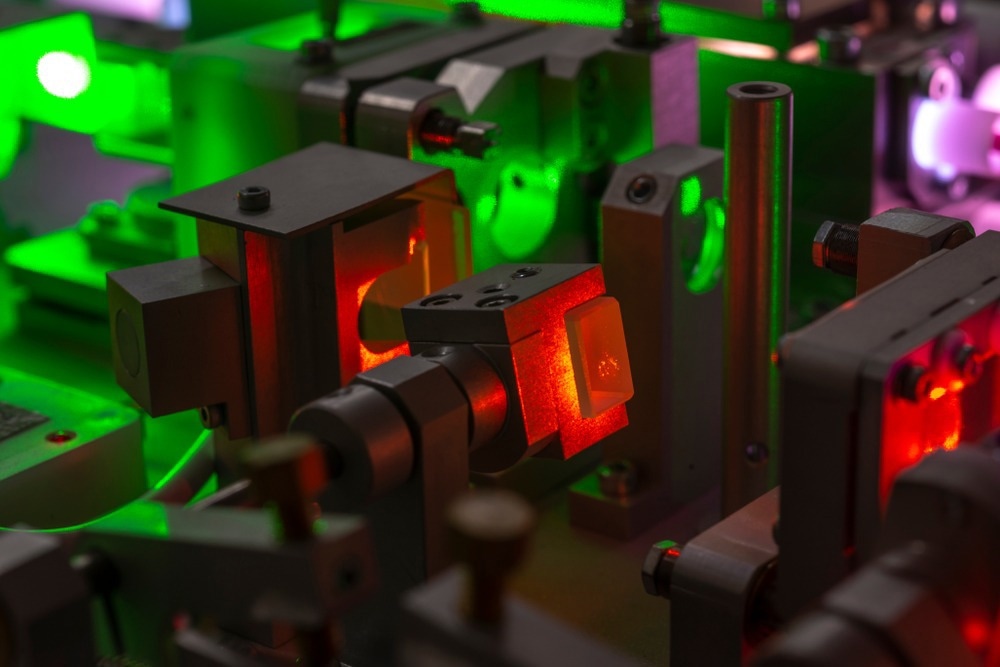Nonlinear optics is the branch of optics that studies the properties and the interaction of light in a medium where the polarization density interacts nonlinearly with the electric field of light. This article will explore the basics of nonlinear optics, including its principles, research areas, and applications.

Red laser cross birefringence pattern of nonlinear optical crystal passed through polarizing filter. Image Credit: Yury Zap/Shutterstock.com
Nonlinear optics emerged in the 1960s with the advent of lasers. Over time, it has matured into an exciting and rapidly growing field that plays a significant role in the development of photonic technology and its various applications, such as optical computers, optical signal processing, sensors, ultrafast switches, laser amplifiers, and ultra-short pulsed lasers.
The Underlying Physics of Nonlinear Optics
Optics is the branch of physics that deals with the behavior and properties of light. This expansive field encompasses many topics, from light reflection off metallic surfaces to creating images.
In linear optics, light intensity directly influences the medium's response. For instance, the refractive index of a transparent medium (water or glass) changes with the light's intensity.
On the other hand, nonlinear optics involves a nonlinear relationship between the electric field of light and the medium's response. The medium's response depends on the light's wavelength, intensity, direction, and polarization.
The interaction between the electric field of light and electrons and atoms in the medium produces nonlinear responses. However, high-intensity light beams can ionize the atoms in the medium, changing the medium's refractive index and generating new frequencies, leading to various optical phenomena, such as frequency mixing, doubling, optical solitons, and parametric amplification.
Applications of Nonlinear Optics
Nonlinear optics has various applications that significantly impact daily life, including telecommunications, commercial lasers, sensors, manufacturing, medicine, scientific instrumentation, and materials processing.
Telecommunications
Nonlinear optics was quickly recognized as the primary constraint on how much data could be transmitted over a single optical fiber in the early days of fiber optic telecommunications.
Nonlinear optics restricts transmission distances and data rates that can be simultaneously transmitted as laser power levels rise. The limitations of nonlinear optics were initially discovered in undersea applications due to the long lengths of fibers. However, it is now understood that nonlinear optics is crucial in designing advanced fiber optic systems.
Analytical Tools
Combining nonlinear optics with microscopy can be highly beneficial for analyzing material changes. For example, confocal microscopy can provide in vivo analysis of biological processes and systems at the microscopic level, while nonlinear optics offer localized functionality and higher-resolution images.
Diversifying Lasers and Coherent Light
Adding a nonlinear optics component to the laser cavity can create new types of lasers and applications. This allows for modifications to the time dependence and color of the laser light. Alternatively, the nonlinear optics component can be placed outside the laser cavity to change the coherence of the emitted light.
Optical Imaging
Nonlinear optical imaging is a promising tool for analyzing pharmaceuticals. It utilizes optical phenomena such as stimulated Raman scattering, second harmonic generation, two-photon excited fluorescence, and coherent anti-stokes raman scattering.

Image Credit: Yury Zap/Shutterstock.com
These imaging techniques have several advantages, such as solid-state and chemical specificity, non-invasive analysis, high optical temporal and spatial resolution, and no labeling and compatibility requirements in biological and aqueous environments.
Research Areas in Nonlinear Optics
Nonlinear optical systems are simple and offer an ideal testing ground to investigate various universal concepts in nonlinear pattern formation.
Biophotonics
Biophotonics explores the interaction between biological materials and light. Compared to linear optics, nonlinear offers several advantages for investigating biological systems. For instance, near-IR excitation allows deeper tissue penetration with minimal photodamage, and the nonlinear signal dependence enables intrinsic 3D optical sectioning. Furthermore, it is possible to obtain label-free biochemical contrast of living tissues by utilizing selected biomolecules' intrinsic nonlinear optical responses.
Terahertz Photonics
Nonlinear optics has contributed significantly to terahertz (THz) technology's progress, enabling broadband single-cycle THz pulses to be generated using optical rectification.
Technological advancements in ultrafast lasers and nonlinear optics have made it possible to generate intense single-cycle THz pulses with peak electric fields surpassing 107 V/m. The strength of the THz electric field in these ultra-short electromagnetic pulses presents unique prospects for exploring novel nonlinear optical effects in the THz spectral range and investigating ultrafast nonlinear phenomena in the single-cycle regime.
Quantum Optics
Nonlinear optics is a useful tool to control and design interconnects in a quantum network. For instance, in a hybrid quantum network where nodes work at different wavelengths, interconnects like quantum frequency converters or entangled photon pairs enable communication between the nodes. These devices rely on nonlinear optical effects.
Researchers are combining nonlinear optics and integrated photonics with quantum technology to advance modern quantum communication and computation applications to develop new integrated quantum optical devices at telecommunication wavelengths.
Brillouin Scattering
Brillouin scattering, a nonlinear optical phenomenon involving light interaction with sound, has been studied since the early days of nonlinear optics. It has facilitated technological developments in microwave processing, sensing, fast and slow light, optical phase conjugation, and high-coherence source generation.
Nonlinear Optics: An Interdisciplinary Frontier for Innovation and Research
Nonlinear optics has revolutionized the field of optics by enabling advanced lasers and coherent light sources, offering high-resolution spectroscopy, empowering micromachining, high-capacity telecommunications, and new materials analysis tools.
Nonlinear optics is a highly active and dynamic field that has undergone significant research since its creation. It spans various scales, from micrometers to nanometers, and encompasses classical and quantum phenomena. As a result, it has evolved into an interdisciplinary field with many concepts that extend beyond traditional disciplinary boundaries.
More from AZoOptics: What is Photoacoustic Spectroscopy?
References and Further Reading
Li, R., Wang, X., Zhou, Y., Zong, H., Chen, M., & Sun, M. (2018). Advances in nonlinear optical microscopy for biophotonics. Journal of Nanophotonics, 12(3), 033007-033007. https://doi.org/10.1117/1.JNP.12.033007
Joshi, M. P. (2015). Basics of Nonlinear Optics. In Laser Physics and Technology: Proceedings of the School on Laser Physics & Technology, Indore, India, March 12-30, 2012 (pp. 27-64). Springer India. https://doi.org/10.1007/978-81-322-2000-8_2
Lembrikov, B. (2019). Introductory Chapter: Nonlinear Optical Phenomena. Nonlinear Optics - Novel Results in Theory and Applications. https://doi.org/10.5772/intechopen.83718
Garmire, E. (2013). Nonlinear optics in daily life. Optics express, 21(25), 30532-30544. https://doi.org/10.1364/OE.21.030532
He, G. S. (2014). Nonlinear optics and photonics. OUP Oxford. https://doi.org/10.1093/acprof:oso/9780198702764.001.0001
Disclaimer: The views expressed here are those of the author expressed in their private capacity and do not necessarily represent the views of AZoM.com Limited T/A AZoNetwork the owner and operator of this website. This disclaimer forms part of the Terms and conditions of use of this website.